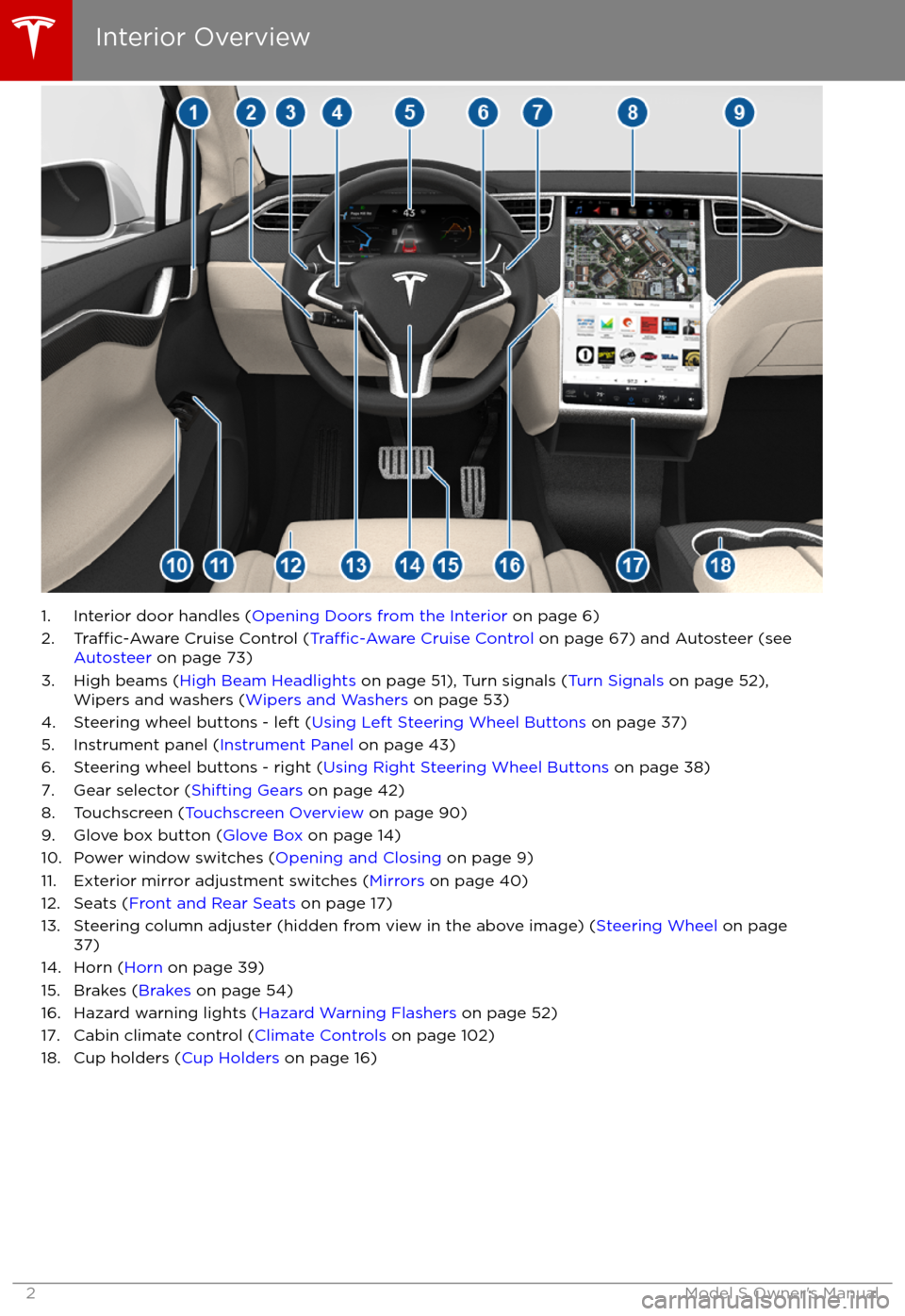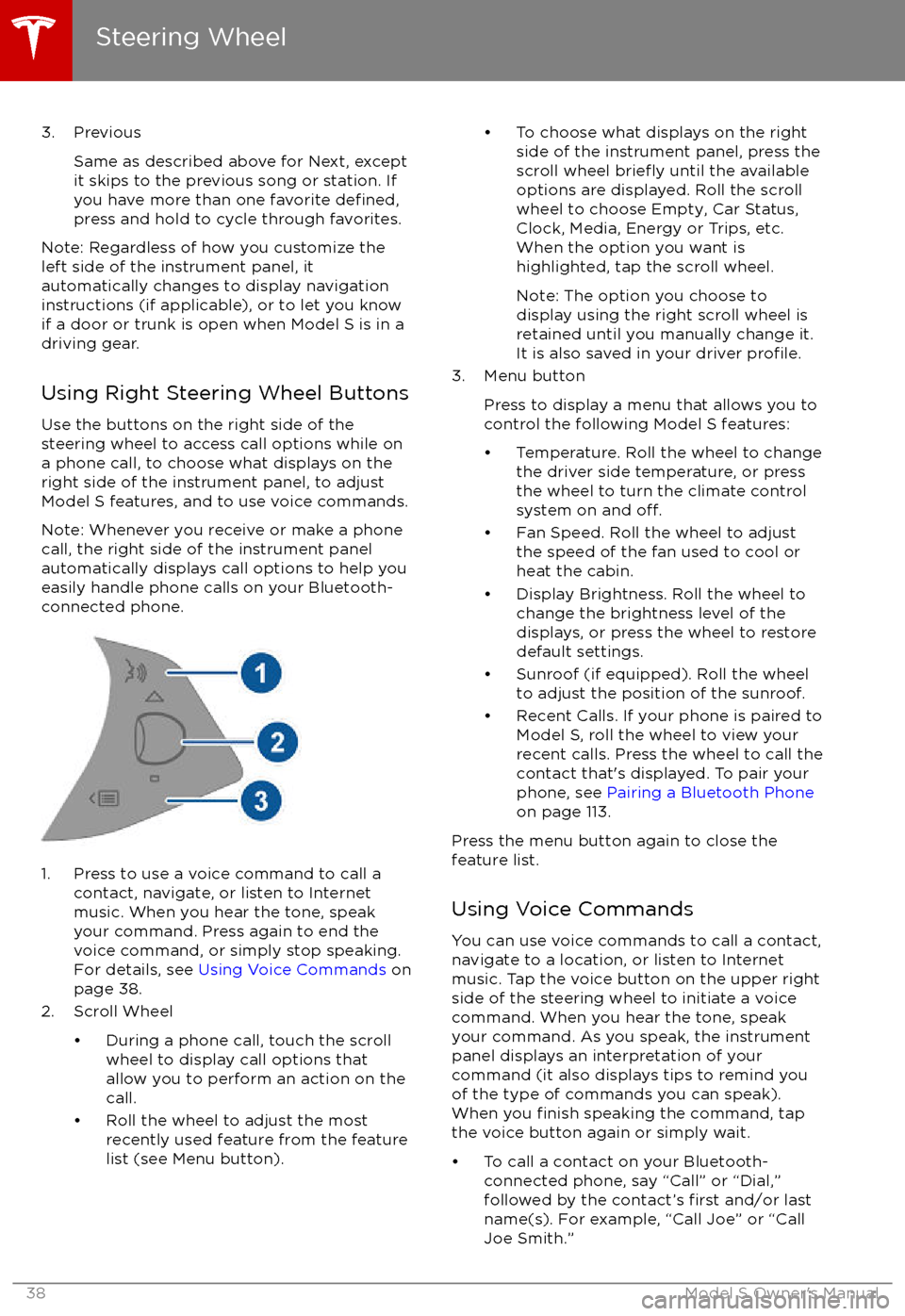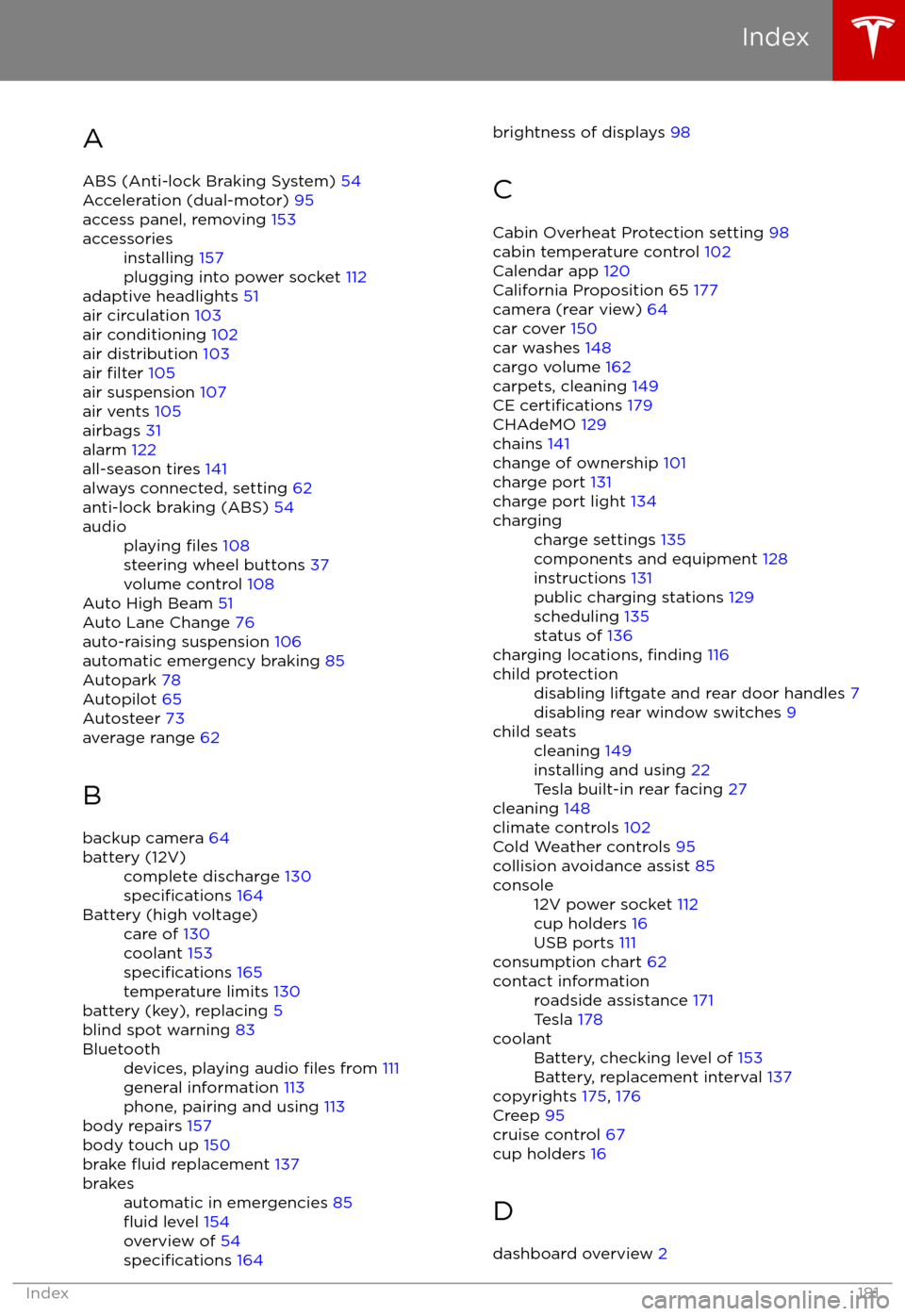2017 TESLA MODEL S buttons
[x] Cancel search: buttonsPage 3 of 188

1. Interior door handles (Opening Doors from the Interior on page 6)
2.Traffic-Aware Cruise Control (Traffic-Aware Cruise Control on page 67) and Autosteer (see
Autosteer on page 73)
3. High beams ( High Beam Headlights on page 51), Turn signals ( Turn Signals on page 52),
Wipers and washers ( Wipers and Washers on page 53)
4. Steering wheel buttons - left ( Using Left Steering Wheel Buttons on page 37)
5. Instrument panel ( Instrument Panel on page 43)
6. Steering wheel buttons - right ( Using Right Steering Wheel Buttons on page 38)
7. Gear selector ( Shifting Gears on page 42)
8. Touchscreen ( Touchscreen Overview on page 90)
9. Glove box button ( Glove Box on page 14)
10. Power window switches ( Opening and Closing on page 9)
11. Exterior mirror adjustment switches ( Mirrors on page 40)
12. Seats ( Front and Rear Seats on page 17)
13. Steering column adjuster (hidden from view in the above image) ( Steering Wheel on page
37)
14. Horn ( Horn on page 39)
15. Brakes ( Brakes on page 54)
16. Hazard warning lights ( Hazard Warning Flashers on page 52)
17. Cabin climate control ( Climate Controls on page 102)
18. Cup holders ( Cup Holders on page 16)
Interior Overview
2Model S Owner
Page 39 of 188

3. PreviousSame as described above for Next, except
it skips to the previous song or station. If
you have more than one favorite
defined,press and hold to cycle through favorites.
Note: Regardless of how you customize the
left side of the instrument panel, it
automatically changes to display navigation
instructions (if applicable), or to let you know
if a door or trunk is open when Model S is in a driving gear.
Using Right Steering Wheel Buttons Use the buttons on the right side of the
steering wheel to access call options while on
a phone call, to choose what displays on the
right side of the instrument panel, to adjust
Model S features, and to use voice commands.
Note: Whenever you receive or make a phone call, the right side of the instrument panelautomatically displays call options to help you
easily handle phone calls on your Bluetooth-
connected phone.
1. Press to use a voice command to call a
contact, navigate, or listen to Internetmusic. When you hear the tone, speak
your command. Press again to end the
voice command, or simply stop speaking.
For details, see Using Voice Commands on
page 38.
2. Scroll Wheel
Page 150 of 188

Cleaning the Interior
Frequently inspect and clean the interior to maintain its appearance and to prevent
premature wear. If possible, immediately wipe up spills and remove marks. For general
cleaning, wipe interior surfaces using a soft
cloth (such as micro
fiber) dampened with a
mixture of warm water and mild non-
detergent cleaner (test all cleaners on a
concealed area before use). To avoid streaks,
dry immediately with a soft lint-free cloth.
Interior Glass
Do not scrape, or use any abrasive cleaning
fluid on glass or mirrored surfaces. This can
damage the reflective surface of the mirror
and the heating elements in the rear window.
Airbags
Do not allow any substance to enter an airbag
cover. This could
affect correct operation.
Dashboard and Plastic Surfaces
Do not polish the upper surfaces of the
dashboard. Polished surfaces are
reflectiveand could interfere with your driving view.
Leather Seats
Leather is prone to dye-transfer which can
cause discoloration, particularly on light
colored leather. White and tan leather is coated with an anti-soiling treatment. Wipespills as soon as possible using a soft cloth
moistened with warm water and non-
detergent soap. Wipe gently in a circular
motion. Then wipe dry using a soft, lint-free
cloth. Using detergents or commercially
available leather cleaners and conditioners is
not recommended because they can discolor or dry out the leather.
Polyurethane Seats
Wipe spills as soon as possible using a soft
cloth moistened with warm water and non-
detergent soap. Wipe gently in a circular
motion. After cleaning, allow the seats to air
dry.
Cloth Seats
Wipe spills as soon as possible using a soft
cloth moistened with warm water and non-
detergent soap. Wipe gently in a circular
motion. Then wipe dry using a soft, lint-free
cloth. Vacuum the seats as needed to remove
any loose dirt.
Carpets
Avoid over-wetting carpets. For heavily soiled
areas, use a diluted upholstery cleaner.
Seat Belts
Extend the belts to wipe. Do not use any type
of detergent or chemical cleaning agent.
Allow the belts to dry naturally while
extended, preferably away from direct
sunlight.
Tesla Built-In Rear Facing Child Seats
Vacuum the seats to remove any loose dirt. Wipe the seats with a soft cloth dampened
with warm water. You can also use an upholstery cleaner designed for automotive
use. Extend the belts to wipe. Allow the belts
to dry naturally, preferably away from direct
sunlight.
Touchscreen and Instrument Panel
Clean the touchscreen and instrument panel
using a soft lint-free cloth
specificallydesigned to clean monitors and displays. Do not use cleaners (such as a glass cleaner) and
do not use a wet wipe or a dry statically- charged cloth (such as a recently washed
microfiber). To wipe the touchscreen without
activating buttons and changing settings, you
can enable clean mode. Touch Controls > Displays > Clean Mode. The display darkens to
make it easy to see dust and smudges.
Chrome and Metal Surfaces
Polish, abrasive cleaners or hard cloths can
damage the
finish on chrome and metal
surfaces.
Cautions for Interior Cleaning
Warning: If you notice any damage on an
airbag or seat belt, contact Tesla
immediately.Warning: Do not allow any water,
cleaners, or fabric to enter a seat belt
mechanism.Caution: Using solvents (including alcohol), bleach, citrus, naphtha, orsilicone-based products or additives on
interior components can cause damage.Caution: Statically-charged materials can
cause damage to the touchscreen or
instrument panel.
Cleaning
Maintenance149
Page 182 of 188

AABS (Anti-lock Braking System) 54
Acceleration (dual-motor) 95
access panel, removing 153accessoriesinstalling 157
plugging into power socket 112
adaptive headlights 51
air circulation 103
air conditioning 102
air distribution 103
air
filter 105
air suspension 107
air vents 105
airbags 31
alarm 122
all-season tires 141
always connected, setting 62
anti-lock braking (ABS) 54
audioplaying files 108
steering wheel buttons 37
volume control 108
Auto High Beam 51
Auto Lane Change 76
auto-raising suspension 106
automatic emergency braking 85
Autopark 78
Autopilot 65
Autosteer 73
average range 62
B backup camera 64
battery (12V)complete discharge 130specifications 164Battery (high voltage)care of 130
coolant 153
specifications 165
temperature limits 130
battery (key), replacing 5
blind spot warning 83
Bluetoothdevices, playing audio files from 111
general information 113
phone, pairing and using 113
body repairs 157
body touch up 150
brake
fluid replacement 137
brakesautomatic in emergencies 85fluid level 154
overview of 54
specifications 164
brightness of displays 98
C Cabin Overheat Protection setting 98
cabin temperature control 102
Calendar app 120
California Proposition 65 177
camera (rear view) 64
car cover 150
car washes 148
cargo volume 162
carpets, cleaning 149
CE
certifications 179
CHAdeMO 129
chains 141
change of ownership 101
charge port 131
charge port light 134
chargingcharge settings 135
components and equipment 128
instructions 131
public charging stations 129
scheduling 135
status of 136
charging locations, finding 116
child protectiondisabling liftgate and rear door handles 7
disabling rear window switches 9child seatscleaning 149
installing and using 22
Tesla built-in rear facing 27
cleaning 148
climate controls 102
Cold Weather controls 95
collision avoidance assist 85
console12V power socket 112
cup holders 16
USB ports 111
consumption chart 62
contact informationroadside assistance 171
Tesla 178coolantBattery, checking level of 153
Battery, replacement interval 137
copyrights 175, 176
Creep 95
cruise control 67
cup holders 16
D
dashboard overview 2
Index
Index181
Page 185 of 188

nose cone, removing 173
O
occupancy sensor 33
odometer 61
overhang dimensions 161
overtake acceleration 67
Owner Information, about 175, 176
P
Park Assist 57
Park gear 42
parking brake 55
parking, automatic 78
parts replacement 157
passenger detection 33
passenger front airbag 33
personal data, erasing 101phonesteering wheel buttons 38
using 113
PIN 35
power management 62
power socket 112
power windows 9
powering on and
off 41
Preconditioning 98
preferences, setting 98
Proposition 65 177
public charging stations 129
R
radar 65
radio 108
Radio Frequency information 179
rain sensor 53
rangedisplayed on instrument panel 43
driving tips to maximize 62
regenerative braking 55
range assurance 62
Range mode 62
Range Mode 95
Rated range 98
re-routing 117
rear seats, folding and raising 18
rear view camera 64
rear window switches, disabling 9
Recent (Media Player) 110
Recents 115
regenerative braking 55
region format 98
release notes 126
Reverse gear
42
RFID transponders 157
roadside assistance 171
roof racks 160
rotating tires 139
route overview 117
S safety defects, reporting 178safety informationairbags 34
child seats 26
rear facing child seats 30
seat belts 21
satellite radio 109
seat beltscleaning 149
in a collision 20
overview of 19
pre-tensioners 20
wearing when pregnant 19
seat covers
18
seat heaters 102
seating capacity 159
seatsadjusting 17
heaters 102
Tesla built-in rear facing 27
security settings 122
sensors 65
service data recording 177
service intervals 137
Settings 98
Settings, erasing 101
shifting gears 42
Show Commute Advice 117
side collision avoidance 83
side collision warning 83
SiriusXM 109
slip start 56
Smart Preconditioning 98
software reset 101
software updates 126
specificationscargo volume 162
dimensions 161
exterior 161
interior 161
motor 163
subsystems 163
tires 166
weights 162
wheels 166
stability control 56
starting 41
steering
specifications 163
steering wheel
Index
184Model S Owner
Page 186 of 188

steering wheel (continued)adjusting position 37
adjusting sensitivity 37
buttons 37
heated 37
scroll bars 37
steering, automatic 73
Streaming radio 109
summer tires 141
Summon 78
sunroof 15
suspension 107
suspension
specifications 164
T
telematics 177
temperatureBattery (high voltage), limits 130
cabin, controls for 102
heated steering wheel 39
outside 43
tires 169
tie-down straps
174
tilt detection 122
Tire and Loading Information label 159
tire noise 141
Tire Pressure Monitoring SystemFCC certification 180
overview of 142
tire pressures, checking 138
tire repair kitinflating with air only 146inflating with sealant 145
replacing the sealant canister 147tiresall-season 141
balancing 139
chains 141
industry glossary of terms 170
inspecting and maintaining 139
pressures, how to check 138
quality grading 169
replacing 140
replacing a tire sensor 142
rotation 139
specification 166
summer 141
temperature grades 169
tire markings 167
tire sealant 144
traction grade 169
treadwear grade 169
winter 141
toll system transponders, attaching 157
tolls, avoiding 117
torque
specifications 163
touch up body 150
touchscreenclean mode 149
cleaning 149
Controls 95
overview 90
Settings 98
software updates 126
Tow mode 172
towing 172
towing a trailer 160
towing eye, locating 173
towing instructions 172
TPMSFCC certification 180
overview of 142
traction control 56
trademarks 175, 176
Traffic-Aware Cruise Control 67Traffic-Based Routing 117
trailer hitches 160
transmission
specifications 163
transponders, attaching 157
Transport Canada, contacting 178
transporting 172
trip chart 62
trip meter 61
trip overview 117
trip planner 117
trunk, front 12
trunk, rearchild protection lock 7
disabling interior handle 7
TuneIn radio 109
turn signals 52
U
ultrasonic sensors 65
uniform tire quality grading 169
Units & Format 98
Unlock on Park 4
unlockingtrunk, front 12
trunk, rear 10
unlocking and locking doors 4
unlocking when key doesn